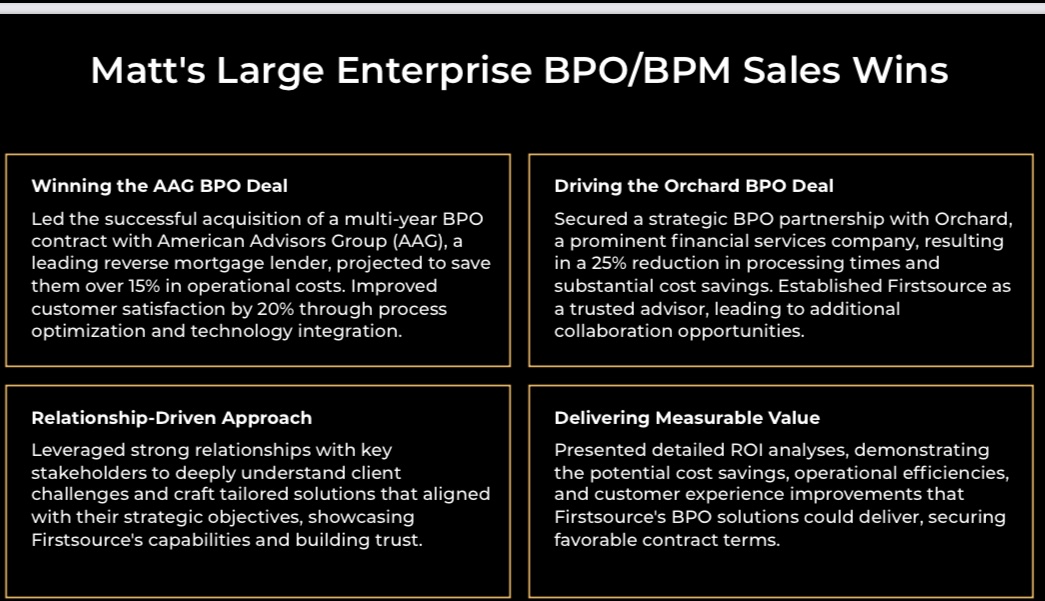Going Big: Winning Enterprise BPM Clients
Jan 24, 2025
In the competitive landscape of Business Process Management (BPM), winning enterprise deals demands a strategic approach, a deep understanding of industry trends, and a well-structured plan for implementation. My journey to securing major contracts for a large BPM client, particularly with Orchard and American Advisors Group (AAG), was not only about closing deals but also about positioning our services to meet the evolving needs of our clients.
The Journey to Winning Enterprise Deals
My initial engagement with Orchard began with identifying their need for enhanced operational efficiency amidst a rapidly changing market. They faced significant challenges in processing times and customer satisfaction, which presented a unique opportunity for us to step in as a transformative partner.
Building Relationships
Understanding that trust is the cornerstone of successful partnerships, I adopted a relationship-driven approach. I initiated conversations with key stakeholders at Orchard, engaging in active listening to grasp their pain points and strategic objectives. By aligning our BPM solutions with their goals, I positioned our firm as a trusted advisor, not just a service provider. This foundation of trust would prove invaluable as we moved forward.
Delivering Measurable Value
Next, I focused on delivering measurable outcomes. I presented a detailed ROI analysis, showcasing how our BPM solutions could reduce processing times by 25% and improve customer satisfaction metrics. Furthermore, I organized a workshop where our technical team demonstrated our innovative technology solutions, allowing Orchard's team to visualize the potential transformation. This hands-on experience helped underline our capabilities and fostered confidence in our approach.
Securing the Deal
As negotiations progressed, I maintained open lines of communication, ensuring that all stakeholders felt engaged and valued. This collaborative dialogue was essential in addressing any concerns and reinforcing our commitment to their success. Ultimately, Orchard chose to partner with us, resulting in a multi-year BPM contract that opened doors to further collaboration opportunities.
This success was mirrored in my subsequent engagement with AAG, where I leveraged the same relationship-driven strategy. By understanding their specific needs, I demonstrated how our tailored solutions could achieve a 15% reduction in operational costs, leading to another significant win.
Turning to Key Trends in BPM for 2025:
As I reflect on my experiences, several key trends in BPM are shaping the industry:
1. Automation and AI Integration: Organizations are increasingly seeking BPM solutions that incorporate advanced technologies like AI and automation to enhance efficiency and reduce manual intervention.
2. Customer-Centric Processes: There is a growing emphasis on designing processes that prioritize customer experience, ensuring that every interaction adds value and satisfaction.
3. Data-Driven Decision Making: Clients are leveraging data analytics to inform their BPM strategies, allowing them to make more informed decisions and continuously improve their processes.
4. Agility and Adaptability: In today’s dynamic market, businesses require BPM solutions that can quickly adapt to changing business conditions and regulatory requirements.
5. Sustainability and Social Responsibility: Clients are becoming more aware of their environmental and social impacts, leading to a demand for BPM solutions that support sustainability initiatives.
My 90-120 Day Plan for Helping BPM Clients
To capitalize on these trends and ensure our BPM clients achieve their goals, I have developed a comprehensive 90-120 day plan:
Days 1-30: Orientation and Assessment
- Conduct a thorough analysis of the client’s current BPM practices, including process mapping and performance metrics.
- Meet with key stakeholders to understand their vision, challenges, and goals.
- Research industry trends to identify opportunities and threats that may impact the client’s operations.
Days 31-60: Strategy Development and Relationship Building
- Develop a strategic sales plan that aligns with the client’s objectives, focusing on high-impact areas for improvement.
- Strengthen relationships with key clients through regular check-ins and feedback sessions.
- Facilitate workshops to foster collaboration and innovation within the client’s teams, encouraging cross-functional communication.
Days 61-90: Implementation and Evaluation
- Begin executing the strategic sales plan, prioritizing initiatives that deliver quick wins while laying the foundation for long-term improvements.
- Establish key performance indicators (KPIs) to measure the success of implemented initiatives and team performance.
- Schedule regular check-ins to assess progress, address challenges, and refine the strategy as needed.
Days 91-120: Continuous Improvement and Growth
- Analyze feedback from clients to identify areas for further enhancement and innovation.
- Conduct a comprehensive review of accomplishments, challenges faced, and lessons learned during the transition period.
- Position our firm as a thought leader by sharing insights and case studies on BPM best practices, reinforcing our role as a trusted advisor.
By focusing on these key trends and implementing a structured approach, I am committed to helping our BPM clients navigate their challenges and achieve sustainable growth in an ever-evolving landscape. The journey may be complex, but with a clear plan and a dedication to delivering value, the rewards can be transformative for both our clients and our firm.

